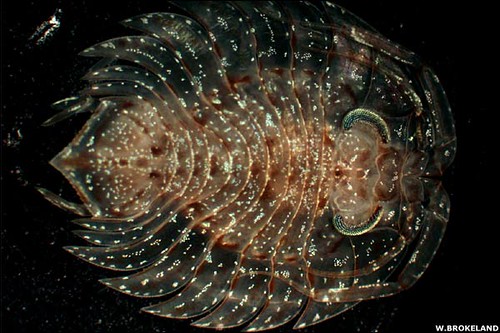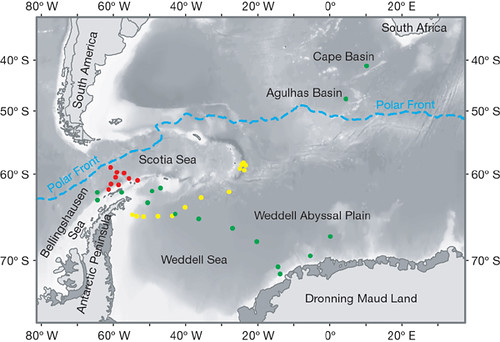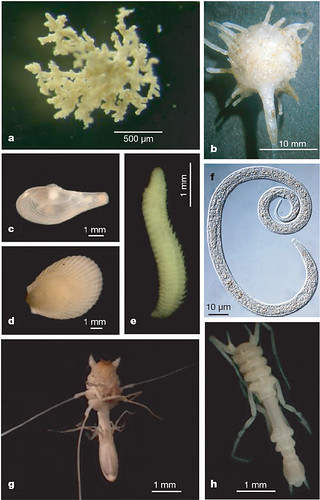tags: Antarctica, Weddell Sea, new species, ANDEEP, zoology
The scientists said an "astonishingly diverse" collection of isopods had been discovered. This young male isopod represents one of 674 isopod species found.
Image: W. Brokeland. [larger image]
According to a paper that was recently published, scientists have found more than 700 new species of marine creatures in seas surrounding Antarctica -- seas once thought too hostile to sustain such rich biodiversity. Fabulous creatures, such as carnivorous sponges, free-swimming worms, crustaceans and molluscs, were collected.
The discoveries astonished scientists, who were not expecting to find such a dynamic and biologically rich environment in what is such a dark and forbidding region.
"What was once thought to be a featureless abyss is in fact a dynamic, variable and biologically rich environment," said Katrin Linse, an author of the paper and a marine biologist from British Antarctic Survey (BAS). "Finding this extraordinary treasure trove of marine life is our first step to understanding the complex relationships between the deep ocean and distribution of marine life."
According to Linse, preliminary DNA analyses suggest that the world's deep sea areas were colonised by creatures from the Antarctic.
The research formed part of the Andeep (Antarctic benthic deep-sea biodiversity) project, which is the first comprehensive study of Antarctic marine life, which is intended add to our knowledge about the fauna that inhabit the deeper parts of the Southern Ocean. Andeep sent the RV Polarstern on three collecting expeditions between 2002 and 2005, and an international team collected tens of thousands of specimens from the Weddell Sea, from depths of between 774 and 6,348 meters (2,539-20,826 feet). Specimens were collected from diverse settings, including the continental slope, the abyssal plain and channel levees.
Figure 1: Station map. Stations from ANDEEP I (2002) red circles, ANDEEP II (2002) yellow circles and ANDEEP III (2005) green circles. The blue line indicates the Polar Front. [larger image]
At least 50,000, and possibly more than 100,000, animal specimens were from more than 1,000 species were recovered, many of which are completely new to science. For example, they collected more than more than 13,000 isopods from 674 species of isopod (a diverse order of crustaceans pictured at top) 585 of which had never previously been described; more than 200 polychaete species (marine worms), 81 of which were found to be new species; and 76 sponges, 17 of which had previously been unknown. Many of the 758 new species of animal were tiny, measuring a fraction of an inch long, from a huge range of ecological niches.
Figure 2: Selected important ANDEEP taxa. a, A new species of komokiacean (Ipoa sp. nov.) from the Weddell Sea abyssal plain. b, The carnivorous sponge Chondrocladia from the Weddell Sea abyssal plain. c, Bivalve mollusc Cuspidaria sp. from the abyssal Weddell Sea and South African basins. d, Bivalve mollusc Limatula sp. from the Weddell Sea. e, Polychaete Ophryotrocha from the Weddell Sea. f, Nematode Molgolaimus sp. from the Weddell Sea. h, Isopod crustacean Ischnomesus sp. from the Weddell Sea. g, Isopod Munnopsis sp. from the western Weddell Sea. [larger image]
"I initiated the Andeep project because such a vast area of the Southern Ocean had never been explored," said Lead author of the paper, Angelika Brandt, who is based at the Zoological Institute and Zoological Museum, University of Hamburg, Germany. "We thought we might find some novel species, but previous research had suggested deep-sea diversity this far south would be poor, so we were very surprised to find such enormous diversity."
The discoveries could provide a deeper understanding of the evolution of ocean life in this area, said Brandt. By comparing the species that are found in the deep-sea and those found in the shallower waters surrounding Antarctica, scientists will learn how climate and the environment that these animals live in drove previous evolutionary changes.
"Finding this extraordinary treasure trove of marine life is our first step to understanding the complex relationships between the deep ocean and distribution of marine life," said Brandt.
Further, the Antarctic ice shelf once approached the South American and African continents, forcing many creatures that lived in shallow waters to colonize the sea bed at much greater depths. One of the findings supporting this hypothesis was the mingling of species in deep and shallow Antarctic environments. Similarly, several deep sea creatures were found to have eyes despite living in darkness.
"The Antarctic deep sea is potentially the cradle of life of the global marine species. We now have a better understanding in the evolution of the marine species and how they can adapt to changes in climate and environments."
Sources
First insights into the biodiversity and biogeography of the Southern Ocean deep sea, by Angelika Brandt, Andrew J. Gooday, Simone N. Brandão, Saskia Brix, Wiebke Brökeland, Tomas Cedhagen, Madhumita Choudhury, Nils Cornelius, Bruno Danis, Ilse De Mesel, Robert J. Diaz, David C. Gillan, Brigitte Ebbe, John A. Howe, Dorte Janussen, Stefanie Kaiser, Katrin Linse, Marina Malyutina, Jan Pawlowski, Michael Raupach & Ann Vanreusel. Nature 447, 307-311 (17 May 2007) | doi:10.1038/nature05827. (abstract and PDF). (images, story)
The Australian (quotes)
BBC News (quotes)
- Log in to post comments




Nice article - thanks for the post
They're amazing!
Creepie Crawlies! ! !
What a fabulous story! Antarctica is the true "final frontier."